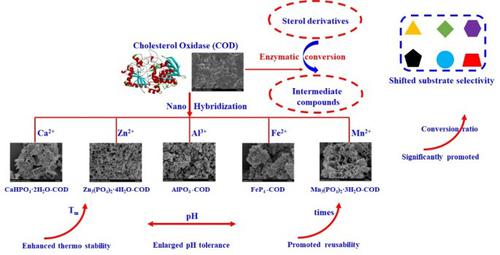Frontiers of Chemical Science and Engineering ( IF 4.3 ) Pub Date : 2020-12-01 , DOI: 10.1007/s11705-020-1989-7 Yu Xin , Qiuyue Gao , Yu Gu , Mengyao Hao , Guangming Fan , Liang Zhang

|
A cholesterol oxidase (COD) was hybridized with Ca2+,Zn2+,Al3+,Fe2+ and Mn2+. After precipitation with PO43− at 4 °C for 72 h, the resulting pellets were freeze-dried. In scanning electron microscopy assays, the metal-COD complexes revealed flower-like or granular structures after hybridization. Fourier transform infrared spectroscopy assay revealed the characteristic peaks of both the enzyme and metal materials. X-ray diffraction analysis indicated that COD was encapsulated in CaHPO4 · 2H2O-, Zn3(PO4)2·4H2O-, AlPO4-, FeP4- and Mn3(PO4)2· 3H2O-based nanostructures, respectively. Differential scanning calorimetry assay indicated significant increases in thermo-denaturation temperatures from 60.5 °C to 167.02 °C, 167.02 °C, 137.70 °C, 172.85 °C and 160.99 °C, respectively. Using steroid derivatives as substrates, this enzyme could convert cholesterol, pregnenolone, dehydroepiandrosterone, ergosterol, β-sitosterol and stigmasterol to related single products. Hybridization in metal-based nanostructures could significantly enhance the initial conversion ratio and reaction stability of the enzyme. In addition, substrate selectivity could be affected by various metal materials. Briefly, using Ca2−,Zn2+, Al3−, Fe2+ and Mn2+ as hybrid raw materials could help to encapsulate COD in related metal-enzyme nanostructures, and could help to promote the stability and tolerant properties of the enzyme, while also enhancing its catalytic characteristics.
中文翻译:

金属-胆固醇氧化酶杂化纳米结构的自组装及其在类固醇衍生物生物转化中的应用
胆固醇氧化酶(COD)与Ca 2 +,Zn 2 +,Al 3+,Fe 2+和Mn 2+杂交。在4°C下用PO 4 3-沉淀72小时后,将所得沉淀冷冻干燥。在扫描电子显微镜分析中,杂交后,金属-COD络合物显示出花状或颗粒状结构。傅里叶变换红外光谱分析法揭示了酶和金属材料的特征峰。X射线衍射分析表明,化学需氧量被封装在CaHPO 4 ·2H 2 O-,Zn 3(PO 4)2 ·4H 2中基于O-,AlPO4-,FeP4-和Mn 3(PO 4)2 ·3H 2 O的纳米结构。差示扫描量热法测定表明热变性温度分别从60.5℃显着增加到167.02℃,167.02℃,137.70℃,172.85℃和160.99℃。以类固醇衍生物为底物,该酶可将胆固醇,孕烯醇酮,脱氢表雄酮,麦角固醇,β-谷甾醇和豆甾醇转变为相关的单一产品。在基于金属的纳米结构中杂交可以显着提高酶的初始转化率和反应稳定性。此外,各种金属材料可能会影响基材的选择性。简而言之,使用Ca 2−,Zn 2 +,Al 3−,Fe 2+和Mn 2+作为杂化原料可以帮助将COD封装在相关的金属酶纳米结构中,并有助于提高该酶的稳定性和耐受性,同时还可以增强其稳定性。催化特性。











































 京公网安备 11010802027423号
京公网安备 11010802027423号